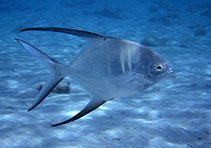
|
Trachinotus goodei Jordan & Evermann, 1896 Great pompano |

|
|
photo by
Wirtz, P. |
| Family: | Carangidae (Jacks and pompanos), subfamily: Trachinotinae | |||
| Max. size: | 50 cm TL (male/unsexed); max.weight: 560.0 g | |||
| Environment: | reef-associated; marine; depth range 0 - 12 m | |||
| Distribution: | Western Atlantic: Massachusetts (USA), Bermuda, and the Gulf of Mexico to Argentina. | |||
| Diagnosis: | Dorsal spines (total): 7-8; Dorsal soft rays (total): 19-20; Anal spines: 2-3; Anal soft rays: 16-18. Dorsal and anal fins have very long, dark anterior lobes (Ref. 26938). Bluish silver on back, shading to silver on sides, with four narrow dark bars on upper of body (Ref. 13442). | |||
| Biology: | Adults form schools in clear coastal areas, usually near coral formations (Ref. 5217). Juveniles common in clean sandy beaches (Ref. 5217). Adults feed on crustaceans, polychaete worms, insect pupae, mollusks and fishes (Ref. 9626). Between 1995 and 2000, at least 2 specimens were traded as aquarium fish at Fortaleza, Ceará (Ref. 49392). | |||
| IUCN Red List Status: | Least Concern (LC); Date assessed: 04 February 2009 Ref. (130435) | |||
| Threat to humans: | reports of ciguatera poisoning | |||